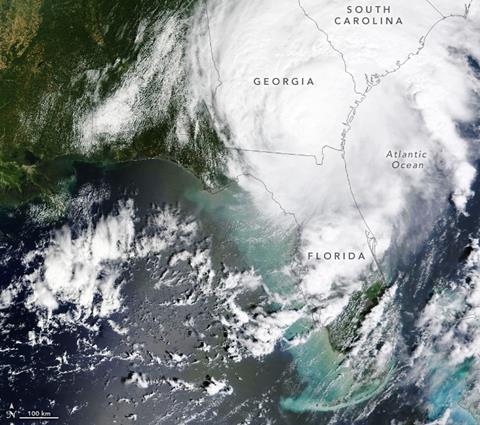The first major hurricane landfall in Florida’s Big Bend since records began in 1842, Idalia could have been much worse had it taken a different track or not weakened before landfall.

Moody’s RMS has published a $3-5bn estimation of private market insured losses resulting from Hurricane Idalia, which made landfall in Florida on 30 August.
That was a notch higher than rival catastrophe modeller Verisk’s $2.5-4bn insured loss estimate for Idalia.
Moody’s RMS said its “best estimate” was for a $3.5bn insured loss within that range.
This estimate reflected insured wind, storm surge, and inland flooding impacts for the US.
Additionally, Moody’s RMS estimated losses to the US government’s National Flood Insurance Program (NFIP) could be in the range of $500m, mostly in Florida.
“Major Hurricane Idalia could have been much more impactful had the storm taken a different track or not weakened just before landfall,” said Jeff Waters, staff product manager, North Atlantic Hurricane Models, Moody’s RMS.
“As a result, the tight gradient of damaging winds combined with limited exposure and low flood take-up rates in the worst-affected area should reduce the overall level of insured losses,” he said.
“Nevertheless, we expect this event will test Florida (re)insurers on the heels of new legislation passed over the last several months to stabilize the market and curb the impacts of social inflation,” Waters added.
Wind losses highest
Within the Moody’s RMS $3-5bn range estimate, wind made up the majority, at $2.2-3.4bn. Flood could contribute up to a third of the total event losses, Moody’s RMS said.
Wind losses also made up the bulk of its own estimate, Verisk said.
“Varying levels of damage inflicted by fallen trees was observed along the path of Idalia. Cities including Tallahassee, Gainesville, Jacksonville, FL and Valdosta, Savannah, GA are reporting a large number of downed trees. This area is dominated by large pine trees, and these can lead to costly cleanup costs, roof replacements and associated costs,” Verisk said.
“Manufactured homes constitute a significant portion of the residential inventory in the Big Bend region of Florida where Idalia made landfall. Several manufactured homes in these areas saw massive damage, including loss of roofs, damage to wall siding and near-total destruction due to wind and surge alike, the latter in coastal areas,” the cat modeler added.
Moody’s RMS said insured wind and NFIP losses will be driven by residential lines, while private market water losses will be dominated by commercial and automobile lines, mostly in Florida. Excluding NFIP claims, storm surge made up a further $0.5-1.3bn; and inland flood contributed another $0.3bn.
Verisk said: “While Idalia made landfall in a sparsely populated region of Florida, catastrophic damage was observed in small communities like Perry, which took the brunt of the storm’s fierce western eyewall shortly after landfall, and Cedar Key, which experienced historic storm surge inundation.
“Fortunately, Tallahassee was largely spared from the worst as the storm’s center passed 60 miles to the east and saw three inches of rainfall and wind gusts into the 40s-mph,” Verisk added.
Big Bend record
Hurricane Idalia made landfall on August 30, 2023, near Keaton Beach, Florida as a Category 3 major hurricane, with maximum sustained winds of 125mph (205kph), resulting in the fourth consecutive year that a major hurricane has made landfall in the US.
Idalia was the ninth named storm of the 2023 North Atlantic Hurricane Season, the third hurricane, and the second named storm to make landfall in the US this season.
The storm was the first major category hurricane to make landfall in the Florida Big Bend region since recordkeeping began in 1842.
It was also the eighth major hurricane to make landfall in the continental US since 2017 – after Harvey, Irma, Michael, Laura, Zeta, Ida and Ian.
“Prior to Idalia, Florida’s ‘Big Bend’ region was largely untested by landfalling major hurricanes. Much of the building stock affected by Idalia is older and built before the onset of statewide building codes during the 1990s,” said Julie Serakos, senior vice president, Moody’s RMS.
“However, wind observations from the event suggest Idalia’s wind speeds were just around the design windspeed levels for the region. In addition, newer roofs on many properties installed in recent years after Hurricanes Irma and Ian should help minimize extensive damage in Florida,” Serakos said.
“As for water impacts, Idalia caused significant storm surge-related damage in several areas along the Florida and southeast US coastlines. For inland flooding, while it was wide in its extent, it was nominal in severity,” she added.
Ongoing inflation and residual impacts from 2022’s Hurricane Ian would have some impact on claims severity for Idalia, RMS Moody’s suggested.
“Construction costs have come down from record levels in recent years, but they remain higher than their long-term averages,” said Rajkiran Vojjala, vice president, model development, Moody’s RMS said.
“Additionally, Florida requires state-certified contractors to complete roof repairs, and the widespread extent of wind damage in Idalia may exacerbate the existing fragile labor situation in Florida and lead to an unexpectedly long recovery,” Vojjala added.










No comments yet